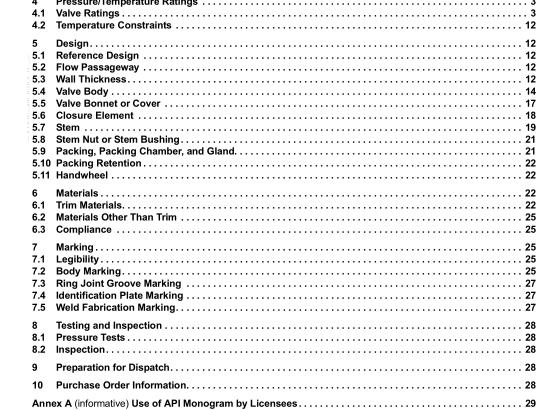API 602:2015 pdf free download.Gate, Globe, and Check Valves for Sizes DN 100 (NPS 4) and Smaller for the Petroleum and Natural Gas Industries
4.2 Temperature Constraints
4.2.1 The temperature for a corresponding pressure rating is the maximum temperature of the pressure-containing shell of the valve. In general, this temperature is the same as that of the contained fluid. The use of a pressure rating corresponding to a temperature other than that of the contained fluid is the responsibility of the user.
4.2.2 Restrictions of temperature and pressure, e.g. those imposed by special soft seals, special trim materials, packing, or bellows stem seals, shall be marked on the valve identification plate (see 7.4).
4.2.3 For temperatures below the lowest temperature listed in the pressure/temperature rating tables (see 4.1), the service pressure shall be no greater than the pressure for the lowest listed temperature. The use of valves at lower than the lowest listed temperature is the responsibility of the user. Consideration shall be given to the loss of ductility and toughness of many materials at low temperature. ASME B31.3 and ASME B31T may be used as guidance. Additional information for cryogenic service valves with body/bonnet extensions can be found in MSS SP-134 and ISO 28921-1.
5 Design
5.1 Reference Design
5.1.1 Requirements for extended body valves are given in Annex B and those for bellows stem seals in Annex C and Annex D. Other configurations and types of material may be provided when specified in accordance with Annex F.
5.1.2 Valve parts are identified in Annex E.
5.1.3 The reference design (the design to be provided when the purchaser does not specify otherwise or does not use Annex F) for sizes DN ≤ 100 (NPS ≤ 4) is for standard bore, bolted-bonnet or cover construction, an outside stem thread for gate and globe valves and, for globe valves, has a conical disc. The reference design for threaded-end valves uses taper pipe threads in accordance with ASME B1.20.1. In addition, for valves DN ≤ 50 (NPS ≤ 2), the reference design is to have a body and bonnet or cover of forged material.
5.2 Flow Passageway
5.2.1 The flow passageway includes the seat opening and the body ports leading to that opening. The body ports are the intervening elements that link the seat opening to the end connection (e.g. socket or flange).
5.2.2 The minimum cross-sectional area requirement for the standard bore flow passageway applies for both the valve body ports and the seat opening in the absence of the valve disc. The minimum flow passageway cross- sectional area shall not be less than that obtained using the diameters in Table 3.
5.2.3 The minimum cross-sectional area requirement for the full-bore flow passageway (except extended body valves) applies for both the valve body ports and the seat opening in the absence of the valve disc. The minimum flow passageway cross-sectional area shall not be less than that obtained using the diameters in Table 4. This standard does not provide for extended body valves (see Annex B) with full-bore openings.
5.3 Wall Thickness
5.3.1 Except as provided for in 5.3.2.and 5.3.3, the minimum wall thickness values for valve bodies, bonnets and check valve covers are given in Table 5. The manufacturer, taking into account such factors as bonnet bolting loads, rigidity needed for stem alignment, valve design details and the specified operating conditions, is responsible for determining if a larger wall thickness is required.
5.3.2 Valve body end connection minimum wall thickness shall be in accordance with 5.4.2, 5.4.3, 5.4.4, or 5.4.5 as applicable. Valves identified as extended body valves shall have body extension minimum wall thickness in accordance with A.3. Valves having bellows stem seals with a bellows enclosure shall have a bellows enclosure extension minimum wall thickness in accordance with B.4.API 602 pdf download.API 602:2015 pdf free download
